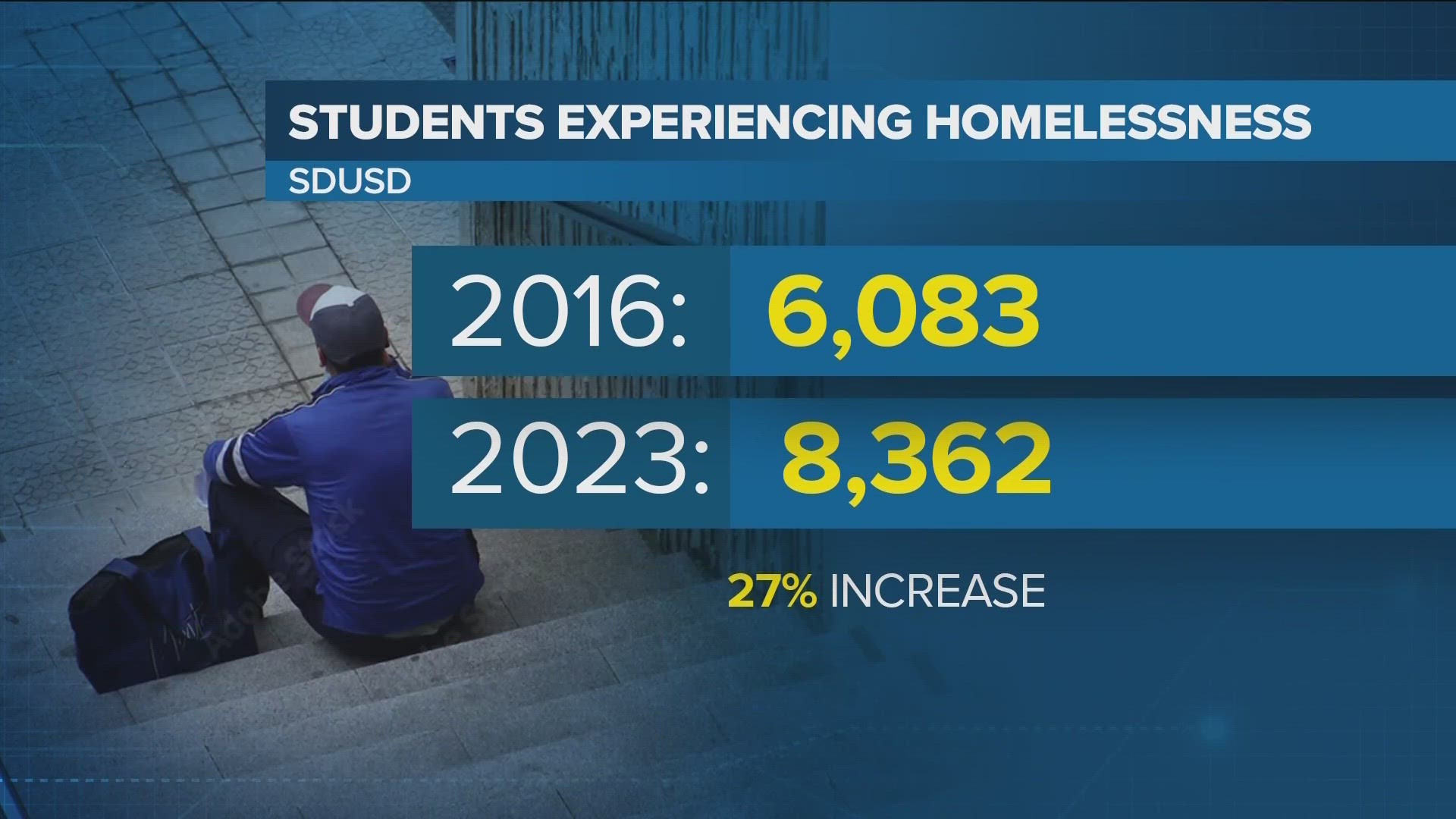SAN DIEGO — In the center of San Diego, tucked in the heart of Mid-City, sits a middle school where 69% of its students consider themselves homeless, the most of any school in the San Diego Unified School District. A few blocks away in City Heights is an elementary school that has 231 homeless students. Less than a mile from both schools is a high school which has 385 children who say they have no permanent residence.
Amid the talks of homeless encampment bans, enforcement and shelter space, is a rising number of homeless students at San Diego city schools.
"For most San Diegans, when they think of homelessness, they think of the adult pushing a shopping cart, or the person on the street corner. They think of somebody who's mentally ill running around the streets. They don't think of a child who doesn't have a place to stay," said Walter Phillips, CEO of San Diego Youth Services. "They don't know so their mind can't go there."
However, according to data obtained by CBS 8, the number of homeless students in San Diego and throughout the region is an issue that residents will soon have to face.
Student homelessness at a seven-year high
Under the McKinney-Vento Act, the California Department of Education defines student homelessness as those who "lack a fixed, regular, and adequate nighttime residence."
According to the district, city schools located south of Interstate 8 in communities such as City Heights, El Cerrito Heights, Lincoln Park, and other older neighborhoods, have the highest numbers of students without permanent housing.
The number of homeless students in San Diego has reached a seven-year high, with over eight percent of all students enrolled in San Diego Unified reporting that they are experiencing homelessness, according to data obtained by CBS 8.
At the outset of the current school year, the second-largest school district in California, reported 8,362 students as homeless, nearly 1,000 more than in 2022 and over 2,200 more than just seven years ago.
It is a crisis that shows no signs of letting up.
Rising housing costs and a limited number of affordable options for families continue to drive the region's homelessness crisis to unprecedented levels. According to monthly data from the Regional Task Force on Homelessness, more individuals and families are entering homelessness than are finding housing in San Diego.
Which students are impacted the most?
The numbers show that elementary school-aged students have a higher rate of homelessness than middle schools and high schools but have not seen the increases that middle schoolers and high school students experienced.
According to the data, nearly 3,800 grade school children said they did not have permanent housing in 2023, up only slightly from the 2022 school year yet down from a high in 2019.
And while the number of elementary school students who were without permanent residences largely remained the same since 2016, the same cannot be said at San Diego Unified middle and high school levels.
In 2016, San Diego city schools reported that 909 middle school students were experiencing homelessness. In the eight years since, that number has shot up to 2,121 middle schoolers, a 133% increase.
At the same time, the number of high school students in San Diego who reported not having permanent housing also saw increases, however, not as drastic as those in junior high.
Data from the district shows that the number of houseless high schoolers jumped by 74% since 2016, from 1,350 students in 2016 to 2,344 this current school year.
The Resources
Shelter space for those living on the streets or without homes is scarce in San Diego, even more so for families with young children and unaccompanied minors.
San Diego Youth Services provides resources for minors who are experiencing homelessness and runs the city's only temporary shelter for unaccompanied homeless youth.
"We see kids as young as 12 that end up on the streets and without a safe place to live or without knowing where their next meal is coming from," said San Diego Youth Services CEO Walter Philips.
Phillips said that he has seen the spike in homeless youth firsthand. He fears that rising housing costs will continue to put more families in jeopardy of losing their homes.
"We see families where the parents lost a job so and don't have money for rent. We work to get these families housed whether temporary or permanent," said Phillips. "We also work with a lot of youth who are unaccompanied that don't have families that end up on the streets."
Phillips told CBS 8 that since the pandemic more and more families, as well as organizations such as San Diego Youth Services, are struggling with rising housing costs.
"If you think from 2016, to now, the cost of rentals has tripled. We used to be able to house a young person in one of our apartments for $1000 to $1200 a month for one bedroom. Those units are now going for $3000 a month," said Phillips.
In addition to nonprofits, San Diego Unified also provides some resources for students in need of help.
A spokesperson for San Diego Unified said the district provides transportation, school supplies, resources for food and housing assistance, as well as school enrichment programs in hopes of tackling the homeless crisis in its schools.
The spokesperson said the district also offers tutoring or counseling for those on the street or in temporary shelters as well.
But, said Phillips from San Diego Youth Services, more needs to be done.
"It's a crisis," said Phillips. "One child on the streets is too many. This should not happen in a country, in a city, as rich as ours. Just one child without a place to lay their head, or a blanket to put over them, is completely unacceptable."

